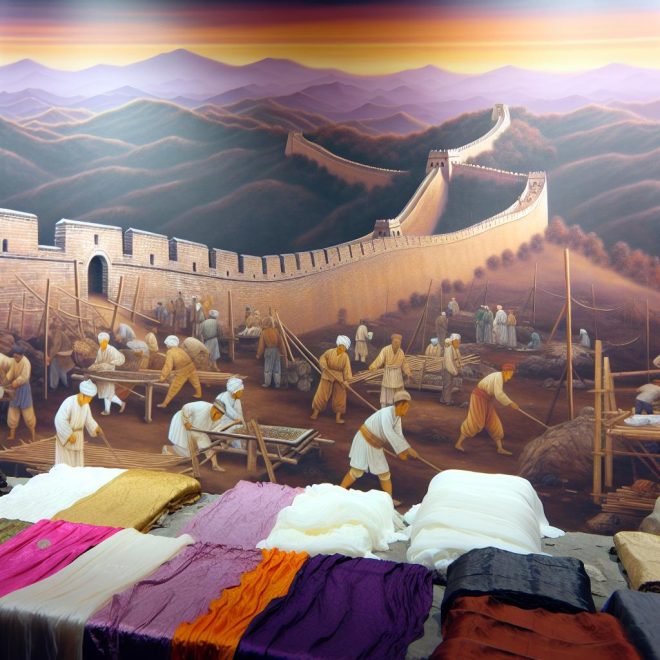Introduction
The Great Wall of China stands as one of history’s most iconic architectural feats, stretching thousands of miles and symbolizing China’s ingenuity and perseverance. However, the construction and maintenance of such a massive structure required significant resources and funding. One of the crucial factors in financing the Great Wall was the trade along the Silk Road. This ancient network of trade routes not only facilitated cultural exchanges but also played an instrumental role in supporting the empire’s economic needs.
The Silk Road: A Brief Overview
The Silk Road can be seen as a defining element in promoting China’s historical development, reaching its peak as it connected China to numerous regions across Asia, the Middle East, and even parts of Europe. It derived its name from the lucrative trade in silk that was carried out along its routes. Merchants and traders exchanged not only textiles but also spices, metals, and other valuable commodities. The Silk Road was vital for economic prosperity, facilitating trade and diplomacy over centuries. With its complex network spanning thousands of miles, it served as a catalyst for economic and cultural links that transcended borders and civilizations.
Economic Impact of the Silk Road
The trade facilitated by the Silk Road had a profound economic impact across the regions it connected. By accessing foreign markets, China was able to export large quantities of silk, which was a highly sought-after commodity in many parts of the world. The production of silk in China, followed by its transportation and trading, was a process that required not only raw materials but also skilled artisans and elaborate trading operations. This robust commercial activity provided immense revenue, which significantly boosted the Chinese economy.
This economic development had a ripple effect, extending the benefits of prosperity and stability far and wide. The resources generated from the silk exports, together with the diverse imports ranging from spices to metals, equipped China with a strong economic foundation. This financial strength was pivotal to supporting large-scale projects such as the construction of the Great Wall, allowing for ambitious planning and implementation.
Allocation of Resources to the Great Wall
The construction and maintenance of the Great Wall required more than just financial resources. It involved labor, materials, and strategic planning. The multifaceted nature of this project demanded a coordinated effort in resource allocation, which was made possible through the economic benefits reaped from the Silk Road trade. Funds sourced from this trade were essential in procuring necessary raw materials like bricks, stones, and wood. Additionally, with a steady flow of resources, the mobilization of labor forces was achievable.
The project employed skilled engineers, architects, and general workers, all of whom were crucial in realizing the construction of this defensive barrier. The expertise and labor required were a testament to the effective allocation of resources, not just financially but also in terms of human capital. This coordination of resources exemplified the broader significance of the Silk Road as more than just a commercial pathway—it was a vital backbone sustaining monumental undertakings like the Great Wall.
Strategic Importance
Another aspect of the Silk Road’s contribution was its strategic significance. The Great Wall was primarily built for defense against the invasions that threatened the stability and prosperity of the Chinese empire. This defensive structure, therefore, had intrinsic economic importance; the prosperity brought by Silk Road trade meant that resources could be allocated to enhance military defenses, including the construction of the wall.
Securing the prosperity of trade routes was essential, and the Great Wall acted as a bulwark to protect these economic interests. The strategic positioning of the wall not only thwarted potential invasions but also facilitated the expansion of borders, thereby maintaining the safety of commercial routes pivotal to both economic and cultural exchanges.
Moreover, the protection of such essential trade routes allowed for the continuity of commerce that was integral to the empire’s socio-economic stability. The Great Wall’s defensive capability indirectly fostered the necessary conditions for continued trade along the Silk Road, reinforcing the symbiotic relationship between commerce and national security.
Conclusion
The intertwining history of the Great Wall of China and the Silk Road highlights how crucial trade was in shaping world history. The Silk Road provided more than just a passage for goods; it enabled the economic conditions necessary for ambitious projects like the Great Wall. Its role extended beyond mere commerce, impacting the socio-political landscapes of entire regions, thereby influencing global history.
The enduring legacy of these historical elements showcases the impact of commerce on infrastructure and underscores trade’s importance in the development of civilizations over time. The economic synergy generated by the Silk Road was an extraordinary orchestration of cultural, material, and intellectual exchanges, driving momentum for civilization’s progress. The Great Wall and the Silk Road stand as testaments to how carefully nurtured commerce can support monumental achievements and how it can continue to inspire and inform the ongoing narrative of human development.
For further reading on the topic, scholars and enthusiasts are encouraged to explore dedicated historical analyses and scholarly sources, both online and in libraries, to gain deeper insights into this fascinating intersection of history, trade, and architecture.
